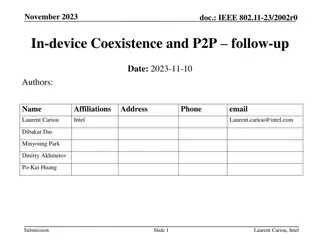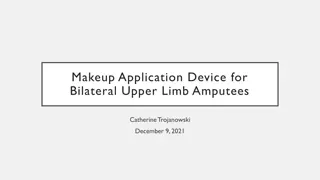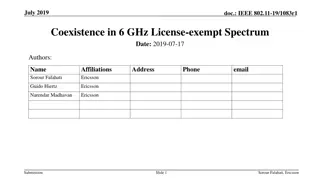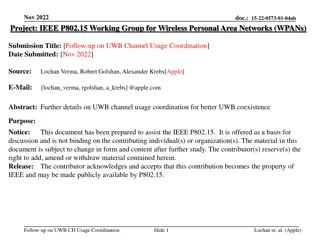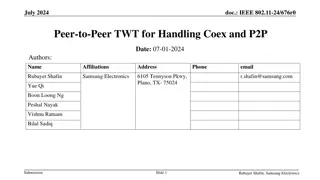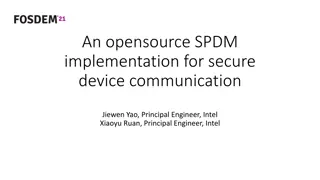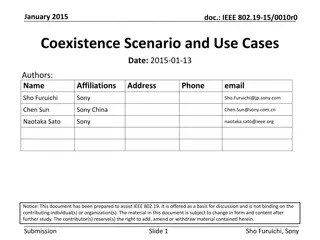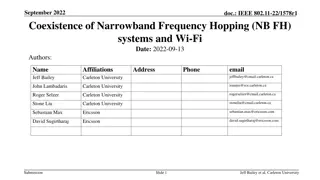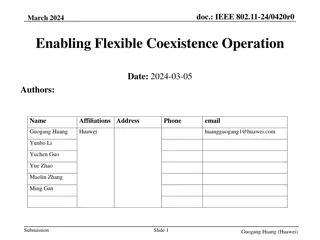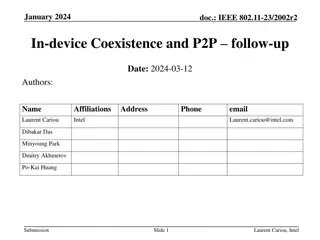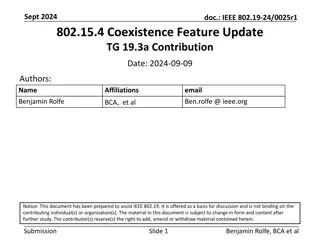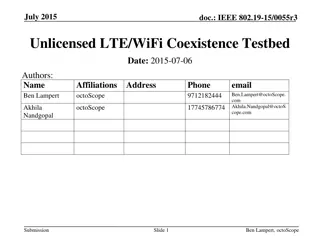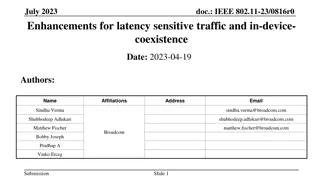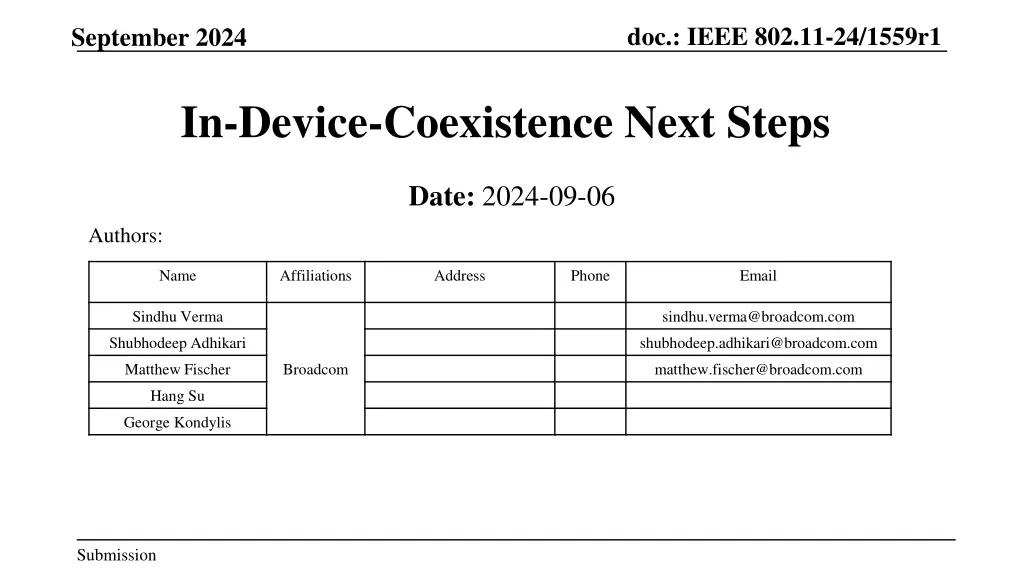
Enhancing In-Device Coexistence Mechanisms in IEEE 802.11-24/1559r1
Explore the next steps in improving In-Device Coexistence through mechanisms defined in IEEE 802.11-24/1559r1, focusing on dynamic unavailability indications and considerations for efficient operations. Topics include defining fields for unavailability indication, start time granularity, impact on WiFi activity, and minimum values for unavailability start time.
Download Presentation

Please find below an Image/Link to download the presentation.
The content on the website is provided AS IS for your information and personal use only. It may not be sold, licensed, or shared on other websites without obtaining consent from the author. If you encounter any issues during the download, it is possible that the publisher has removed the file from their server.
You are allowed to download the files provided on this website for personal or commercial use, subject to the condition that they are used lawfully. All files are the property of their respective owners.
The content on the website is provided AS IS for your information and personal use only. It may not be sold, licensed, or shared on other websites without obtaining consent from the author.
E N D
Presentation Transcript
doc.: IEEE 802.11-24/1559r1 September 2024 In-Device-Coexistence Next Steps Date: 2024-09-06 Authors: Name Affiliations Address Phone Email Sindhu Verma sindhu.verma@broadcom.com Shubhodeep Adhikari shubhodeep.adhikari@broadcom.com Matthew Fischer Broadcom matthew.fischer@broadcom.com Hang Su George Kondylis Submission
doc.: IEEE 802.11-24/1559r1 September 2024 Introduction The following has been agreed in TGbn regarding mechanisms to enhance In-Device-Coexistence: 11bn defines a mechanism for a non-AP STA to report unavailability at TXOP level and define or reuse/update existing mechanism for a non-AP STA to report long term (periodic) unavailability. Thus, there would be a provision for a dynamic unavailability indication and one for a periodic unavailability indication where the periodic unavailability may reuse existing mechanisms. The TXOP-level or dynamic unavailability indications are expected to be exchanged as a part of an ICF- ICR exchange in the beginning of the TXOP or indicated in a management frame. This contribution addresses some of the next steps In-Device-Coexistence. Sindhu Verma et al., Broadcom Submission Slide 2
doc.: IEEE 802.11-24/1559r1 September 2024 Contents of a dynamic unavailability indication (1) The following regarding dynamic unavailability indication has widespread support: Do you support defining the following fields for unavailability indication in M-STA BA frames: An Unavailability Target Start Time field defined as the TSF time at which the STA becomes unavailable (duration and resolution TBD, expectation is to use a portion of the TSF) An Unavailability Duration field defined as the time during which the STA is unavailable (field may be not present or set to an unknown value) Some additional considerations that arise are as follows. The granularity of start time of unavailability indications: This impacts the efficiency of the IDC operation. The coarser the granularity, the higher the margin of unavailability a device needs to use while indicating it. There will be a potential absence of WiFi activity during this additional unavailability. However, it may be small compared to the indicated duration of unavailability. For example, if a typical unavailability duration is 5ms, a granularity of 100us results on an average of 1% additional absence in WiFi activity. The choice of granularity has to also consider the number of bits needed to indicate the maximum start time. For example, with a granularity of 64us, 32.768 ms of start time can be indicated using 9 bits. Sindhu Verma et al., Broadcom Submission Slide 3
doc.: IEEE 802.11-24/1559r1 September 2024 Contents of a dynamic unavailability indication (2) The minimum value of unavailability start time (counting from the end of the ICR) The minimum value of unavailability start time is 0. Ideally, a future start time should allow the AP to process the start time and take necessary actions. The next higher value of unavailability start time is the same as the granularity. For solicited unavailability indication, the start of unavailability can lie within the same TXOP. The TXOP duration remaining until the unavailability start time can be used for transactions with the same non-AP only if it is above a minimum threshold. For unsolicited unavailability indications, the TXOP duration is expected to already account for any upcoming unavailability. The maximum value of unavailability start time (counting from the end of the ICR) It is not useful to have the maximum value of unavailability start time beyond a threshold, as the non-AP would with a high probability be able to send an unavailability indication in a solicited or unsolicited manner before that. The maximum start time is also governed by the application imposing the IDC requirement. Typically, an advance notification of 20ms or so is expected. However, in some cases, the start time can be known even longer in advance. With 9 bits and a granularity of 64us, 32.768 ms of start time can be indicated and will provide sufficient margins. Sindhu Verma et al., Broadcom Submission Slide 4
doc.: IEEE 802.11-24/1559r1 September 2024 Contents of a dynamic unavailability indication (3) The minimum value of unavailability duration The minimum duration of unavailability is the granularity discussed earlier except for the value of 0 which can be designated to mean that the duration is unknown The maximum value of unavailability duration The maximum value of the duration of unavailability is governed by the needs of the application responsible for IDC activity e.g. audio streaming over a Bluetooth headset. Typically the unavailability duration bursts are of the order of 5ms and going up to 16ms. However, in some cases the duration can be longer With a granularity of 64us and with 9 bits, it would be possible to indicate up to 32.768 ms and will provide sufficient margins. Sindhu Verma et al., Broadcom Submission Slide 5
doc.: IEEE 802.11-24/1559r1 September 2024 Volume of dynamic unavailability indications from non-AP to AP Number of upcoming aperiodic dynamic unavailability schedules: For the purpose of limiting complexity, each non-AP STA indicates only one upcoming dynamic unavailability schedule per link This also mitigates the probability of multiple unavailability schedules set up for every non-AP and the requirement to keep modifying them. Sindhu Verma et al., Broadcom Submission Slide 6
doc.: IEEE 802.11-24/1559r1 September 2024 Conclusions This contributions discussed the following aspects that apply to IDC: Contents of a dynamic unavailability indication Changes to previously indicated dynamic unavailability Volume of dynamic unavailability indication Recommendations regarding each of the above aspects Sindhu Verma et al., Broadcom Submission Slide 7
doc.: IEEE 802.11-24/1559r1 September 2024 Straw Poll 1 Do you agree with the following: Unavailability Target Start Time is indicated using 9 bits with a granularity of 64us Unavailability Duration is indicated using 9 bits with a granularity of 64us Y/N/A Sindhu Verma et al., Broadcom Submission Slide 8
doc.: IEEE 802.11-24/1559r1 September 2024 Straw Poll 2 Do you support that The AP maintains up to one unavailability report per STA And the most recent unavailability report (received in a control frame) is the valid one Y/N/A Sindhu Verma et al., Broadcom Submission Slide 9
doc.: IEEE 802.11-24/1559r1 September 2024 Reference [1] IEEE P802.11be /D7.0 [2] 11-23/816r1 Enhancements for latency sensitive traffic and in-device-coexistence Sindhu Verma et al., Broadcom Submission Slide 10


